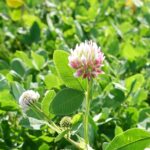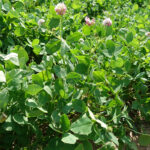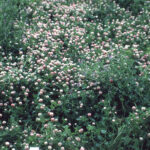Alsike Clover
Trifolium hybridum
General Description
Alsike clover is a fast-growing, generally short-lived perennial clover adapted to the moist acidic soils of the Black, Dark Grey and Grey soils. Most commonly, hardier diploid varieties are grown in Western Canada, but there are also tetraploid types (double the number of chromosomes) with taller plants, larger leaves, and flowers.
Alsike clover has erect to semi-erect, slender, weak stems that grow to 60 cm (24 in). These stems are indeterminate (continually growing) and may become quite long. Both the stems and leaf are hairless. The leaflets are finely toothed with 3 attached at a single point. Alsike clover can often be distinguished from other clovers by the lack of the “V-shaped” watermark (very prominent on leaves of red clover). It has globe-shaped, compact, cross-pollinated flower heads, which form at leaf axils that are pink to white. Alsike clover has well-developed crowns and shallow, non-creeping taproots.
Alsike clover is a fast-growing, generally short-lived perennial clover. Alsike clover has erect to semi-erect, slender, weak stems that grow to 60 cm (24 in). These stems are indeterminate (continually growing) and may become quite long. Both the stems and leaf are hairless. The leaflets are finely toothed with 3 attached at a single point. Alsike clover can often be distinguished from other clovers by the lack of the “V-shaped” watermark (very prominent on leaves of red clover). It has globe-shaped, compact, cross-pollinated flower heads, which form at leaf axils that are pink to white. Alsike clover has well-developed crowns and shallow, non-creeping taproots.
Type
Tame legume.
Origin
Northern Europe. Varieties grown and developed in Canada from 1932 onward.
Longevity
Less than 5 years is standard. However, with crown survival or seed set, alsike clover can persist and live at least 10 years in cool, moist areas of northern or high-altitudes regions. Older stands are common.
Use
Pasture, hay, reclamation. Alsike clover has a higher risk of causing bloat in the lush, vegetative stage. Alsike clover is used for site rehabilitation and soil improvement in forestry contexts and in areas with moist, acidic soils.
Optimal Time of Use
Summer, fall. Alsike clover is hayed at early to full bloom, with regrowth often grazed later. Time grazing to begin once the full canopy develops. While alsike clover can tolerate frequent, close grazing, it has poor tolerance to animal traffic. Short-duration, rotational grazing is optimal for alsike clover.
Recovery After Use
Although alsike clover has indeterminate growth (continually growing), it requires time to build root reserves after grazing and for the last 4-6 weeks in the growing season.
Requires 45-60 days for recovery. Although alsike clover has indeterminate growth (continually growing), it requires time to build root reserves after grazing and for the last 4-6 weeks in the growing season.
Yield
Yields are lower than alfalfa or red clover. Quality of forage is good, and longer lasting than red clover. Alsike produces most of its growth in June. Performance is not consistent from year to year, and adding alsike to a mixture usually lowers yields.
Palatability/Nutritional Value
Alsike clover is very palatable, but can cause bloat, especially in vegetative stages. The risk to cause bloat in grazing livestock is lower than alfalfa and similar to red clover. Alsike clover has a crude protein of approximately 22% and digestibility of 65%. Alsike clover can cause photosensitization and clover poisoning in cattle, sheep, and especially horses, a common problem in the Peace Region.
Alsike clover is very palatable, but can cause bloat, especially in vegetative stages. The risk to cause bloat in grazing livestock is lower than alfalfa and similar to red clover. Alsike clover has a crude protein of approximately 22% and digestibility of 65%. Alsike clover can cause photosensitization and clover poisoning in cattle, sheep, and especially horses.
Annual Precipitation min/max (mm)
400mm / 1500mm
Drought Tolerance
Low tolerance. Requires steady moisture.
Flooding Tolerance
Alsike clover grows best when flooded 2-5 weeks in the spring and can grow in excess moisture conditions or on soils with poor drainage.
Winter Hardiness
Good winter hardiness. If crowns are damaged alsike clover can winterkill.
Soil Texture Preference
Alsike clover does especially well on moist clay to loam soils. It can do well on both peaty (organic) and inorganic soils.
Erosion Control
Little ability to control erosion. Alsike clover may be included in a mix to enhance poorer soil.
Salinity Tolerance
Not saline tolerant.
Acidity Tolerance
Moderate tolerance. Tolerates low acidity with noted pH tolerances of 5.6 to 5.0. Forage specialists indicate alsike clover is similar but slightly less tolerance to acidity than red clover.
Alkalinity Tolerance
Low to moderate tolerance.
Seeds per kg
1,500,000 seeds/kg (680,000 seeds/lb)
Suggested Mixtures
Normally grown in a mix with less competitive grasses such as timothy and meadow bromegrass. Mix with grass for hay to enhance standability and speed windrow dry-down.
Ease of Establishment
Alsike clover is easy to establish but must be seeded shallow (6 mm or 1/4 in). Seedlings can establish in areas where minimal land preparation has occurred. Volunteer establishment can occur and is useful to allow stands to persist long-term. In the first years of production (year after establishment) the proportion of alsike clover can be difficult to manage as it tends to dominate the stand.
Competitiveness
Vigorous and can overtake an area during the first years of production. Crowns naturally breakdown quickly in a stand, so seed set is needed to keep a stand competitive. In the Peace River Region alsike clover spreads easily by seed due to a large, existing soil seedbank.
Vigorous and can overtake an area during the first years of production. Crowns naturally breakdown quickly in a stand, so seed set is needed to keep a stand competitive.
Management Considerations
Allow alsike clover to set seed to establish new plants. Grazing livestock should be monitored for photosensitization and clover poisoning (horses) and bloat (ruminants). Inoculate with Rhizobium trifolii for best nodulation and nitrogen fixing. Alsike thrives in cool, moist areas and may be a good fit for flooded and saturated areas.
Allow alsike clover to set seed to establish new plants. Grazing livestock should be monitored for photosensitization and clover poisoning (horses) and bloat (ruminants). Inoculate with Rhizobium trifolii for best nodulation and nitrogen fixing. Alsike thrives in cool, moist areas and may be a good fit for flooded and saturated areas.
British Columbia Rangeland Seeding Manual, Saskatchewan Dryland Forage Species Adaptation Tool, USDA Plants Database, Alberta Forage Manual, Manitoba Forage Adaptation and Comparison Guide
British Columbia Rangeland Seeding Manual, Saskatchewan Dryland Forage Species Adaptation Tool, USDA Plants Database, Alberta Forage Manual, Manitoba Forage Adaptation and Comparison Guide, OMAFRA Publication 30
Alsike clover is less drought tolerant than white clover, and is less tolerant of hot temperatures. This limits its suitability to the Interior Cedar-Hemlock, wetter parts of the Interior Douglas-fir zone, and to higher elevation irrigated and subirrigated areas in the Bunchgrass, Ponderosa Pine and dry Interior Douglas-fir zones.
Alsike clover is adapted to the Sub-Boreal Spruce, Sub-Boreal Pine-Spruce, and Interior Cedar-Hemlock zones. It is less drought tolerant than white clover, and is less tolerant of hot temperatures. In the southern part of the Central Interior it is suited to wetter parts of the Interior Douglas-fir zone, and to irrigated and subirrigated areas in the Bunchgrass zone and dry parts of the Interior Douglas-fir zone.


